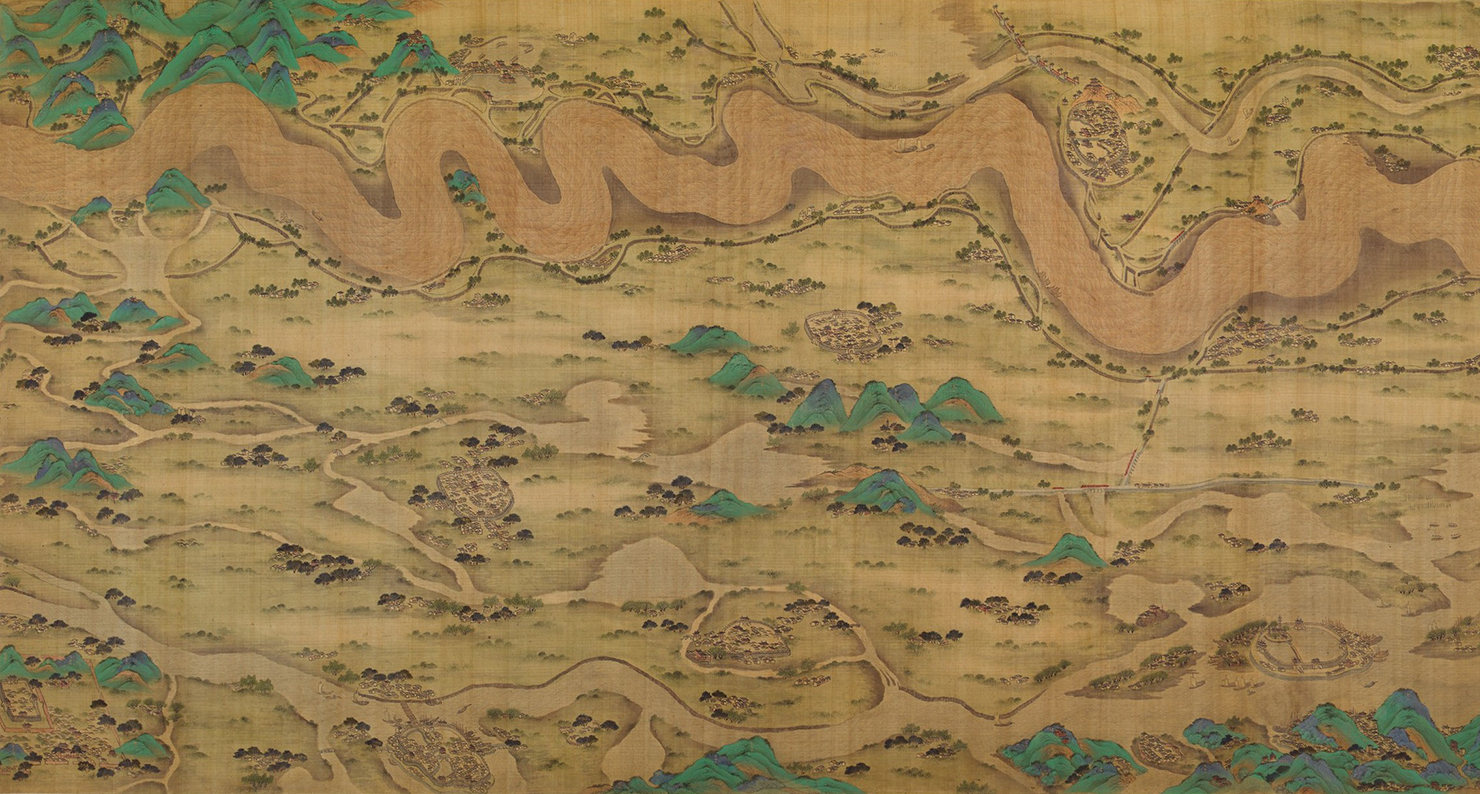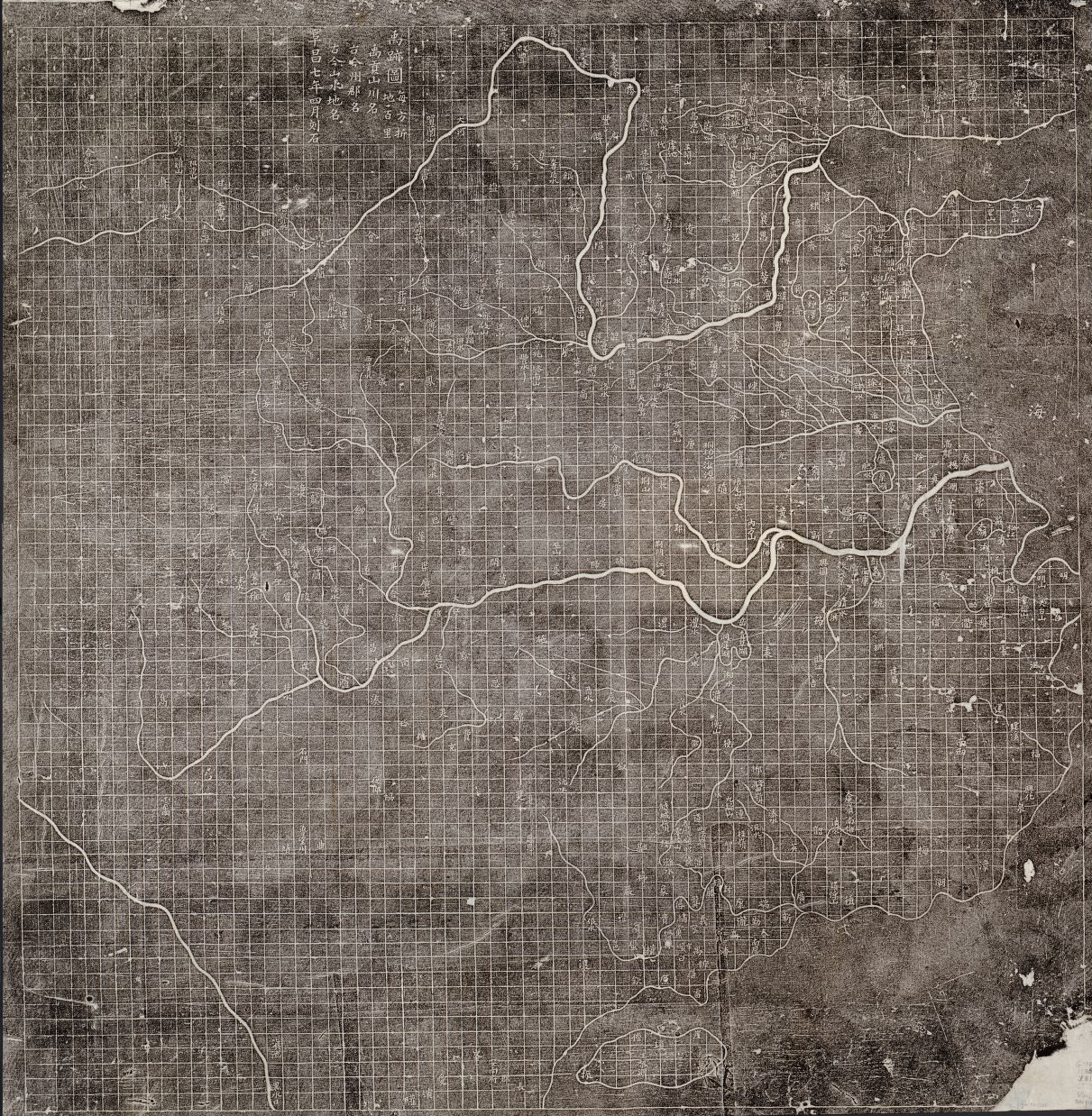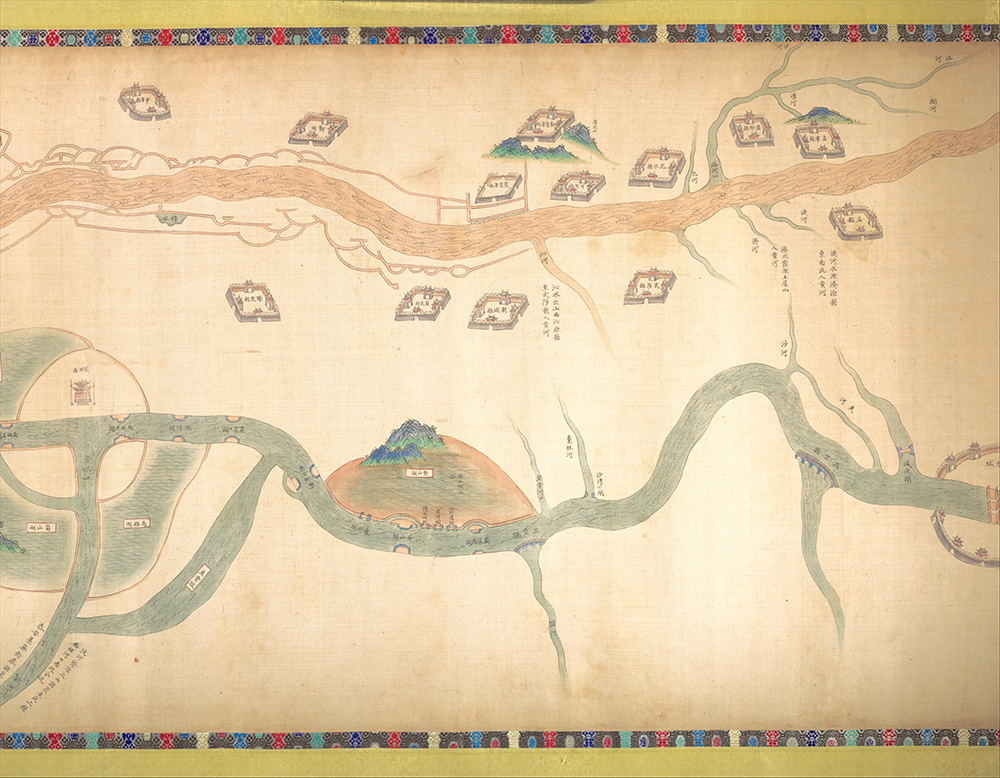
Ten Thousand Miles along the Yellow River (detail), by an unidentified Chinese artist, 1690–1722. The Metropolitan Museum of Art, Purchase, W.M. Keck Foundation Gift, The Dillon Fund Gift, and gifts from various donors, in memory of Douglas Dillon, 2006.
When Confucius described water as “twisting around ten thousand times but always going eastward,” he seemed to imply that the eastbound flow of rivers was tantamount to a law of nature, almost a moral precept. There is no clearer illustration of how a culture’s geography may affect its worldview. Why would anyone who had never stepped foot outside China have any reason to doubt that this was how the world was made?
In China the symmetry of east and west is broken by tectonic forces. Westward lie the mountains, the great Tibetan plateau at the roof of the world, pushed upward where the Indo-Australian plate crashes into and plunges beneath the Eurasian. Eastward lies the ocean: only Taiwan and Japan block the way to the Pacific’s expanse, which might as well be endless. The flow, the pull, the tilt of the world, is from mountains to water, from shan to shui.
This is the direction of the mighty waterways that have dominated the country’s topographic consciousness. “A great man,” wrote the Ming scholar and explorer Xu Xiake, “should in the morning be at the blue sea, and in the evening at Mount Cangwu,” a sacred peak in southern Hunan province. To the perplexity of Western observers (not least when confronted with Chinese maps), the innate mental compass of the Chinese points not north–south, but east–west. The Chinese people articulate and imagine space differently from Westerners—and no wonder.
All of China’s great rivers respect this axis. But two in particular are symbols of the nation and the keys to its fate: the Yangtze and the Yellow River. These great waterways orient China’s efforts to comprehend itself, and they explain a great deal about the social, economic, and geographical organization of its culture and trade. The rivers are where Confucius and Lao Tzu went to think, where poets like Li Bai and Du Fu went to find words to fit their melancholy, where painters discerned in the many moods of water a language of political commentary, where China’s pivotal battles were fought, where rulers from the first Qin Emperor to Mao and his successors demonstrated their authority. They are where life happens, and there is really nothing much to be said about China that does not start with a river.
The great rivers drove some of the earliest stirrings of an impulse to explore and understand the world. The Yü Ji Tu (“Tracks of Yü” Map), carved in stone sometime before the twelfth century, shows how Chinese cartography was far ahead of anything in Christendom or classical Greece. In medieval maps of Europe the rivers are schematic ribbons, serpents’ tails encroaching from the coast in rather random wiggles. But the Yü Ji Tu could almost be the work of a Victorian surveyor, depicting the known extent of the kingdom with extraordinary fidelity and measured on a very modern-looking grid. It is dominated by the traceries of river networks, with the Yellow River and the Yangtze given bold prominence. These are the “tracks” defined by China’s first great water hero, the legendary emperor Yü who conquered the Great Flood.

China has always been interested in—one might fairly say obsessed with—its rivers. The Shui jing (Classic of the Waterways) was the canonical text of hydrological geography, traditionally credited to Sang Qin of the Han dynasty, although later scholars have placed it in the third and fourth centuries (the Jin dynasty). We don’t know quite what it contained, since it has been lost, but a commentary on the work, known as the Shui jing zhu by the scholar Li Daoyuan (427–527), ran to forty volumes and listed more than 1,200 rivers.
The impassioned searching for the source of the great rivers throughout Chinese history seems almost to betray a hope that it will reveal the occult wellspring of China itself, the fount of the country’s spirit (qi). The source of the Yellow River was debated at least since the Tang dynasty of the seventh to the tenth century, and the Yuan emperor Khubilai Khan dispatched an expedition in 1280 that was supposed to clarify the matter. Yet the point was still being argued seven centuries later, when the China Exploration and Research Society declared that the Yellow River springs from the icy, crystal-clear waters of lakes Gyaring and Ngoring in the Bayan Har Mountains of remote Qinghai.
The source of the Yangtze is disputed even now. An expedition in the 1970s identified it as the Tuotuo, the “tearful” river in Qinghai, but several years later it was assigned to the Damqu instead. There’s ultimately something arbitrary in conferring primacy on one of a river’s several headwater sources, but for the Yangtze the symbolic significance of this choice is too strongly felt for the protagonists to brook any compromise. The classical answer, given in the Yu gong manuscript from the Warring States period of the fifth to the third century BC, was that the Yangtze begins as the Min River in Sichuan. But during the Ming era, iconoclastic Xu Xiake (1586–1641) argued otherwise. He found that the Jinsha River, which joins the Min in Sichuan, goes back much further than the Min: a full 2,000 kilometers, deep into the wilds of the Qinghai plateau. The Jinsha (Golden Sand, referring to the alluvial gold that may be found in the river’s sediment) itself stems from the Dangtian, whose tributaries in Qinghai vie as the ultimate source of the Yangtze, flowing from the glacier lakes of that high and inhospitable land.
No one better personifies the Chinese devotion to its great rivers than Xu Xiake, who wandered for thirty years into remote places, suffering robberies, sickness, hunger, and all manner of hazards. “He would travel,” one contemporary account relates,
with a servant, or sometimes with a monk and just a staff and cloth bundle, not worrying about carrying a traveling bag or supplies of food. He could endure hunger for several days, eating his fill when he found some food. He could keep walking for several hundred li, ascending sheer cliffs, braving bamboo thickets, scrambling up and down, hanging over precipices on a rope, as nimble as an ape and as sturdy as an ox. He used towering crags for his bed, streams and gullies for refreshment, and found companionship among fairies, trolls, apes, and baboons, with the result that he became unable to think logically and could not speak. However, as soon as we discussed mountain paths, investigated water sources or sought out superior geographical terrain, his mind suddenly became clear again.
From shui to shan: what more nourishment could the mind need? And to get there, Xu believed, one should not march like a soldier but wander like a poet.
In the person of Xu Xiake, Confucian rectitude meets Daoist instinctiveness and reverie. He was born in the city of Jiangyin, northwest of Shanghai on the Yangtze delta. For much of his travels Xu was attended by a long-suffering servant named Gu Xing. The pair often had to rely on the benevolence of local monasteries for food and shelter, where Xu might offer payment in kind by writing down the history of the institution. On one occasion they were attacked and robbed by bandits on the banks of the Xiang River in Hunan, left destitute but lucky to be alive. Perhaps we can forgive Gu for finally robbing and deserting his master.
Xu journeyed into snowy Sichuan and harsh, perilous Tibet, where rivers could freeze so fast that wandering cattle could get trapped and perish in the ice. He went deep into the steamy Yunnan jungle, then still a region alien, foreign, and wild, to determine that the Mekong (called the Lancang in China), Salween (Nu), and Red (Lishe) rivers were separate entities along their entire courses. But although he diligently recorded the local geology and mineralogy, there is little that is systematic in his itinerary: he was wandering more or less without plan or destination.

Still he deserves to be called a geographer. His methods of surveying were crude, but they rejected the local superstitions that until then supplied the usual rationale for natural phenomena. His notes, according to the great scholar of Chinese science and technology Joseph Needham, “read more like those of a twentieth-century field surveyor than of a seventeenth-century scholar.” And like his contemporaries in Europe, he was prepared to risk censure by preferring the testimony of experience over that of classical authorities. There had been whispers ever since the Han era that the true headwaters of the Yangtze were not, as the classics insisted, the Min, but instead the Jinsha flowing from the Kunlun Mountains of Qinghai. Xu, however, was the first to dare make the claim openly. For this he was denounced as despicable.
Ancient scholarly study of China’s rivers and waters reveals how far ahead of the West Chinese theory and practice were, not only in cartography but in an understanding of natural phenomena. While the Shan hai jing (Classic of Mountains and Seas, probably written in the Warring States period) was content to ascribe the tides to the comings and goings of a massive leviathan-like creature in the oceans, the Han scholar Wang Chong argued in the first century that tides are related to the moon. “The rise of the wave follows the waxing and waning moon,” he wrote, “smaller and larger, fuller or lesser, never the same.” Wang Chong championed a rationalistic explanation of the world over the rather superstitious Daoism and formulaic Confucianism of his time, and his meteorological and astronomical observations were particularly astute. He described the essence of the hydrological cycle (even if his belief in the link between the moon and water extended to a lunar influence on rainfall): “Clouds and rain are really the same thing. Water evaporating upwards becomes clouds, which condense into rain, or still further into dew.” Wang Chong perceived the same correspondences between the movements and forms of river water and of blood circulation that were noted by Leonardo da Vinci a millennium and a half later. He wrote:
Now the rivers in the earth are like the pulsating blood vessels of a man. As the blood flows through them they throb or are still in accordance with their own times and measures. So it is with the rivers. Their rise and fall, their going and coming are like human respiration, like breath coming in and out.
The value of such beliefs, as many historians of science have noted, is not so much a matter of whether or not they are true, as of their capacity to stimulate further observation and to explain the world in naturalistic terms. The importance of the waterways created an imperative for such speculations, just as it drove the development of technologies and systems for making careful measurements and records, for example so that water levels could be determined during dredging operations. Cartography was so far advanced in China from the Han to the Ming eras partly because water management was accorded such priority.
One seems to have little choice but to retain the outmoded name for the Yangtze when discussing it in English; the modern Pinyin transliteration Yangzi feels somehow pedantically perverse. The name is in any event only a local one, derived from the ancient and now mostly forgotten fiefdom of Yang and strictly applying only to the last 300 kilometers. This was the entire “Yangtze” to the first Western travelers, since they rarely got much further upriver.

The Chinese people do not use those names. There are local names for each stretch of the river, but the full channel, cutting the country in half geographically, climatically and culturally, is simply the Chang Jiang, the Long River. It is the longest in all of China, 6,380 kilometers from the source in a glacier lake to the great delta on the coast beyond Shanghai, where the alluvium pushes out into the sea and adds steadily to China’s vast surface area. “A China without such an immense torrent at its heart is almost impossible to contemplate,” says the writer Simon Winchester. Even this understates the matter. Without the Yangtze, China would not be the nation it is today. Time and again, the river has determined the nation’s fate, whether that is by presenting a barrier to barbarian conquest, or a transport network, or a conduit for foreign invasion, or a source of fertility, flood, and revolutionary fervor. Many pivotal battles in Chinese history took place on the middle reaches. The Yangtze cliffs provide the backdrop to the classic Sanguo yanyi (Romance of the Three Kingdoms) from the early Ming period, one of Mao Zedong’s favorite books, in which the river hosts allegedly the biggest naval battle in history. The Yangtze was the artery of conquest and dominance when the British gunships humiliated the Qing emperor in the mid-nineteenth century, and again when the Japanese invaded in the 1930s: steadily pushing upriver from Shanghai to Nanjing and then Wuhan, they forced Chiang Kai-shek’s Nationalists to relocate the government right back beyond the Three Gorges in Chongqing.
China is cloven in two by the Long River, and the two halves could seem like separate nations: the north cold and dry, the south hot and wet. In the north you eat wheat noodles; in the south, rice. Northerners, it is said, are tall and haughty, whether eastern Manchurian stock or Islamic Uyghurs to the west. The southerners, in contrast, are earthy, pragmatic, always on the make, a patchwork of minority races and mutually incomprehensible dialects. That division—decreed by nature, patrolled by the Yangtze—establishes the defining tension within the nation, in which the question is how unity can persist in the face of such a disparity of the most fundamental resource, water. Such stereotypical polarities do scant justice to the bewildering variety of China, of course, but they serve as crude shorthand for the contrasts that you find once you cross the Yangtze.
Reprinted with permission from The Water Kingdom: A Secret History of China by Philip Ball. Published by the University of Chicago Press in the United States/The Bodley Head in the United Kingdom. Copyright © 2016 by Philip Ball. All rights reserved.